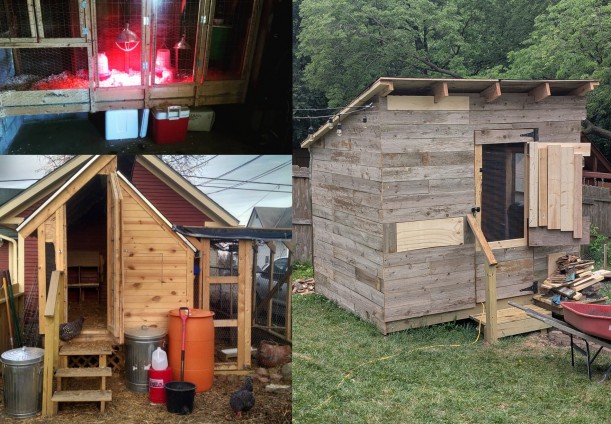Keeping Chickens Ain’t About The Money

Matt's homemade coops over the years. (Matt Hebert)
I have been keeping chickens off and on for over 10 years now. In fact, in 2016 I made my very first Instagram post (@jerkofalltradeshebert), showing my one and only attempt at delving into meat birds after raising laying hens for a year or two. For the record, I would raise chickens for meat again but put a lot more thought into the planning. Now, I could have made an economic case for the meat birds. At a couple bucks a piece for chicks, and a couple fifteen-dollar bags of feed, I probably spent about seven or eight dollars per bird over the 10-week time that I raised them. At the end, I had insanely plump chicken breasts, sizable wings,and thighs, and left several as whole roasters. But for now, I’m going to focus on the pros, cons, and economics of keeping chickens for eggs.
I built all three of the coops I’ve had from scratch and my own original design, and the first was probably the best example of the kind of adaptive thinking that I would recommend you try. That first one was built in my garage, where I used a compartment-like lean-to that gave me approximately sixteen square feet and some good exterior adjacency to provide outdoor access. It required the least amount of cash and resources, and I had great access to electricity and good predator protection. The only problem is that it was located right where we pulled the front of our car up to, so not only was it hard to work around, but I’m certain we were consistently scaring the bejesus out of our little birds. Sixteen square feet is also very small and only good for a few birds. But, if you can locate your coop in the back end of an existing shop or shed, then you might actually save more money than you spend.
My second coop was built right behind the same garage shop space at my old house in South O. It started by looking like a Tim Burton set piece thanks in large part to the cross ventilation I had designed, but it was cute, and I could walk inside. Being able to enter a coop is not necessary at all, which probably drives the size, shape, functionality, and most importantly, cost of your set-up. But you know what, I wanted a decent sized coop and once they get so big, you really don’t want to have to be reaching in on your belly to grab this or that. I probably spent several hundred dollars over the years to improve, winterize, and beautify. But when we sold that house, I was able to strip the chicken functions out and market it as a garden shed. That coop got a lot of use and at the same time that I was raising my meat birds in the old garage coop, I had a dozen laying hens in this one. Mind you, this was pre-kids when I seemed to have 30 hours in a day. This one sat up on posts and the chickens actually got in and out through a trap door in the floor. In retrospect, the interstitial crawl space underneath, while providing good protection for the birds, completely contradicted my point about having to crawl on your belly to get at a bird or loose egg. Garden implements were used regularly.
But I am a learning man, even if I learn from bumps and bruises, and after our five-ish year hiatus from bird keeping, I came back this past spring with a new coop at our new house and two little girls eager to help whether I like it or not.
Our third coop is probably the most functional yet. I once again built it big enough to walk into, but I made sure to keep several classic considerations for building siting in mind. For example, I kept the egg collection and the entrances for both us and birds on the south side. This helps keep them out of a cold north wind, but also allows some of that southern exposure to stay warm and frost-free with what little winter sun it can get. On the other hand, I built some, but not all of the coop off the ground as it sits on a slope. That means that the chickens have a good foot or two that they can duck under to get out of the sun and heat, but not so much that I can’t just reach under there to get them. The egg collection door is something I didn’t have before. At coop number two, I had to open the door and walk inside to collect eggs. With this newest coop, the flap to get to the laying boxes is closest to our deck stairs. Another advantage of a larger, walk-in coop is that my laying boxes are completely inside versus the ones on smaller, pre-built coops that jut out from the main structure. For smaller coops, this is a space savings measure, but in my coop, these boxes are a couple feet off the floor and their water bucket lives below. Much like my old coop however, I have a single, decent-sized storm window which allows for good natural light inside. Also like the old coop, I oriented this on the side of the coop opposite our house and patio so any nighttime activities, like parties or bonfires, don’t disturb the ladies or confuse their natural rhythms. I went a little more tech-y with this coop and have a light-activated pop door (the door they get in and out of) that opens automatically when the ambient light reaches a certain level and closes again when it gets dark. I also have some solar powered fans that keep the coop ventilated, but not drafty – there’s a big difference.
And that brings us to some of the effort involved. Chicken keeping can be pretty low maintenance if you set things up right. The birds themselves are the easiest part. They put themselves to sleep based on daylight and mine are inside before that auto-door ever closes. I’ve made lower-maintenance feeders and waterers this time around to keep things easy for me and clean and reliable for them. And even as we transition into these shorter late-fall days, we are still collecting a good half-dozen eggs a day. We go through them regularly, and any extras go to family and friends for a nominal fee. I grab a bag of feed from the store (Menards is even carrying it now) every couple of weeks for about seventeen dollars. So, in simple terms, I’m spending seventeen dollars for about ten dozen good quality eggs. In other words, a dollar and seventy cents a dozen. Sounds great if you ignore the crazy time, effort, and money I’ve spent on this latest coop. But keeping chickens ain’t about the money. And like most things, the experience and fun are part of the appeal for me. The chickens themselves are incredibly entertaining. Growing your own food is very fulfilling. And my girls now get exposed to a core memory I never had. Not to mention, the building of the coop itself is incredibly delightful for me. I even repurposed my old privacy fence to clad most of the structure. Reduce, reuse, recycle!
So, if you’re thinking about chickens, I highly recommend you read up and educate yourself. But you could always follow my lead and just wing it.
Matt Hebert is an engineer and self-published author. His dopamine-fueled creative pursuits have spanned from chicken keeping, sand sculpture, acting, and public speaking, but writing is nearest and dearest to his heart. He lives in Bellevue with his wife and two daughters. You can find him on Instagram at @jerkofalltradeshebert or email him at matt.hebert.books@gmail.com
Opinions expressed by columnists in The Daily Record are not necessarily those of its management or staff, and do not constitute an endorsement or recommendation. Any errors or omissions should be called to our attention so that they may be corrected. Contact us at news@omahadailyrecord.com.
Category:
User login
Omaha Daily Record
The Daily Record
222 South 72nd Street, Suite 302
Omaha, Nebraska
68114
United States
Tele (402) 345-1303
Fax (402) 345-2351




